Overview
The article highlights a concerning reality: autism rates have surged to 1 in 36 young individuals in 2023. This statistic serves as a call to action, urging us to foster awareness and prioritize early intervention. As we delve deeper, we see that this rise in diagnoses is not merely a number; it reflects improved understanding and diagnostic practices. This crucial development underscores the importance of timely support, which can significantly enhance outcomes for children on the spectrum.
For parents navigating this journey, the challenges can feel overwhelming. Many families face uncertainty and fear, but it’s essential to remember that support is available. Engaging with communities and resources can provide the guidance needed to navigate these waters. Sharing experiences and seeking advice can foster a sense of belonging and understanding among those affected.
In conclusion, let us come together to raise awareness and advocate for early intervention. By doing so, we can ensure that every child on the spectrum receives the support they deserve, paving the way for brighter futures.
Introduction
In 2023, the autism prevalence rate has reached a staggering 1 in 36 children, a significant increase that raises urgent questions for parents and caregivers. As families navigate this complex landscape, understanding the implications of these statistics becomes crucial for ensuring timely interventions and support.
What challenges lie ahead for parents in securing the necessary resources? How can they effectively advocate for their children in this evolving environment? This article delves into ten essential insights regarding the current autism rates, providing parents with the knowledge needed to navigate this journey with confidence and clarity.
ASD Media: Empowering Parents with Essential Autism Resources
At ASD Media, we understand the journey of caregivers navigating the complexities of ABA therapy. We are dedicated to providing essential resources that empower you in this important role. Our offerings include:
- Informative articles
- Engaging webinars
- Interactive community forums where you can share your experiences and effective strategies with others who truly understand.
Given the autism rate 2023 now at 1 in 36 young individuals, the need for extensive support is more significant than ever. We recognize the challenges families face and are committed to fostering a nurturing atmosphere that enables you to manage the intricacies of supporting individuals with autism. This approach ensures that you have the necessary tools to assist in your child's development and well-being, while also nurturing a sense of community that is vital for collective learning and growth.
As Kerry Magro wisely states, 'Autism comes with a supportive family, not an instruction manual.' This highlights the importance of community in our shared journey. With 36.5% of caregivers for individuals with developmental disorders utilizing ABA therapy, ASD Media plays a crucial role in guiding families through the therapeutic landscape. Together, we can enhance outcomes for youth facing developmental challenges, ensuring that no one has to navigate this path alone.
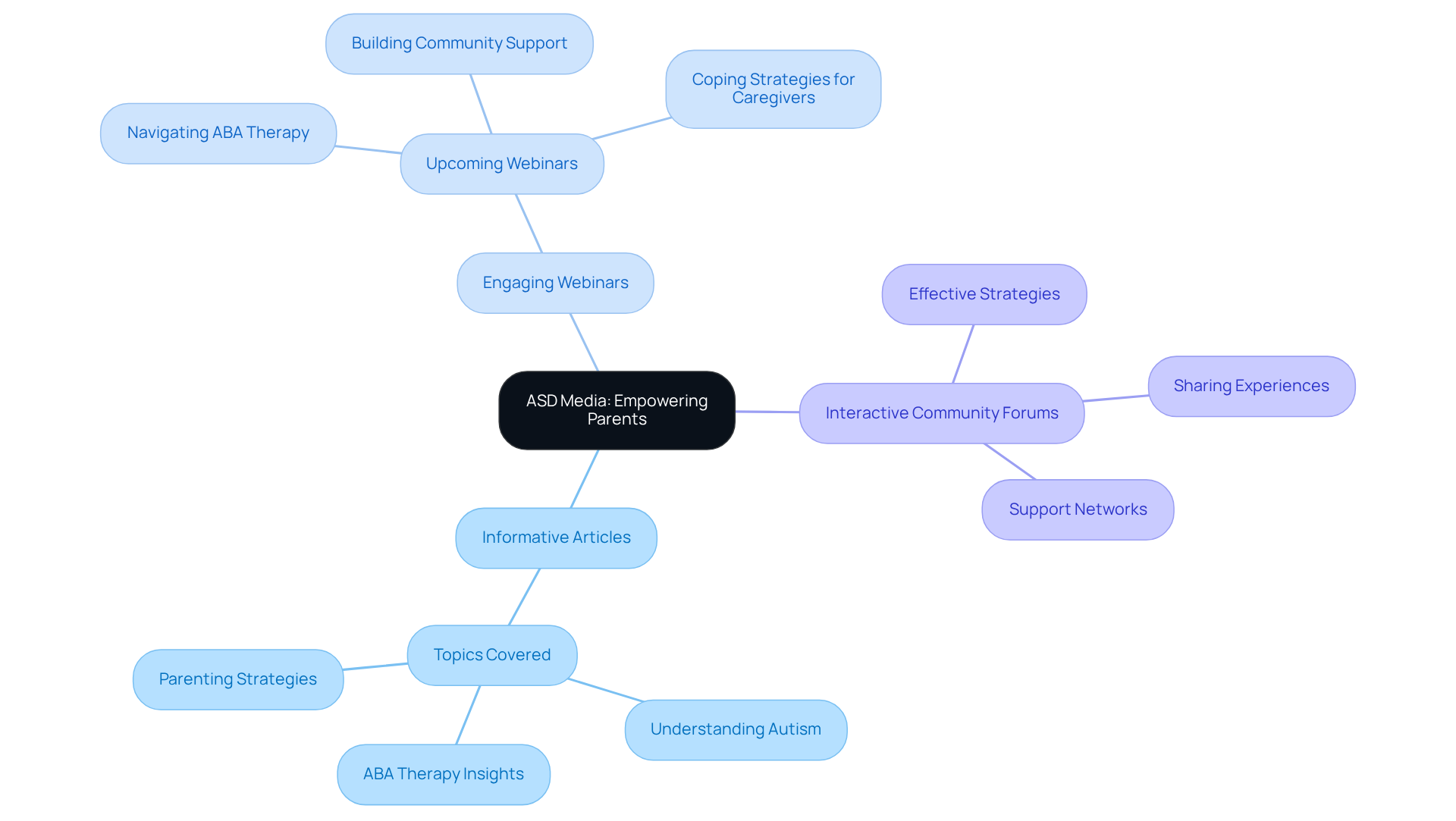
1 in 36 Children: Understanding the Latest Autism Prevalence Rates
Recent data shows that the autism rate 2023 indicates approximately 1 in 36 youths in the U.S. are diagnosed with autism spectrum disorder (ASD), which is a significant increase from earlier estimates of 1 in 44. This rise underscores the urgent need for heightened awareness and proactive early intervention. As parents, it’s vital to closely observe your child's developmental milestones and seek evaluations if you have any concerns. Early diagnosis is crucial—it can greatly enhance access to effective support services and resources, ultimately leading to better outcomes for children on the spectrum.
Moreover, research shows that timely interventions can improve developmental trajectories. This makes it essential for parents to act swiftly when they suspect autism-related challenges. Notably, around 26.7% of autistic 8-year-olds in the U.S. experience 'profound developmental disorder,' highlighting the varying levels of severity and the necessity for tailored interventions. Additionally, it's important to recognize that boys are diagnosed with this condition at a rate approximately 4.2 times higher than girls, revealing demographic disparities in diagnoses.
The autism rate 2023 shows that the prevalence of autism has surged by 312% since 2000, further emphasizing the urgency for awareness and early intervention. As Christopher Banks, President and CEO of the Autism Society of America, poignantly states, "It’s important to recognize this improvement; however, the increased prevalence rates mean we urgently need increased access to quality supports and services at the federal and state level." Let us work together to ensure our children receive the support they need as early as possible.
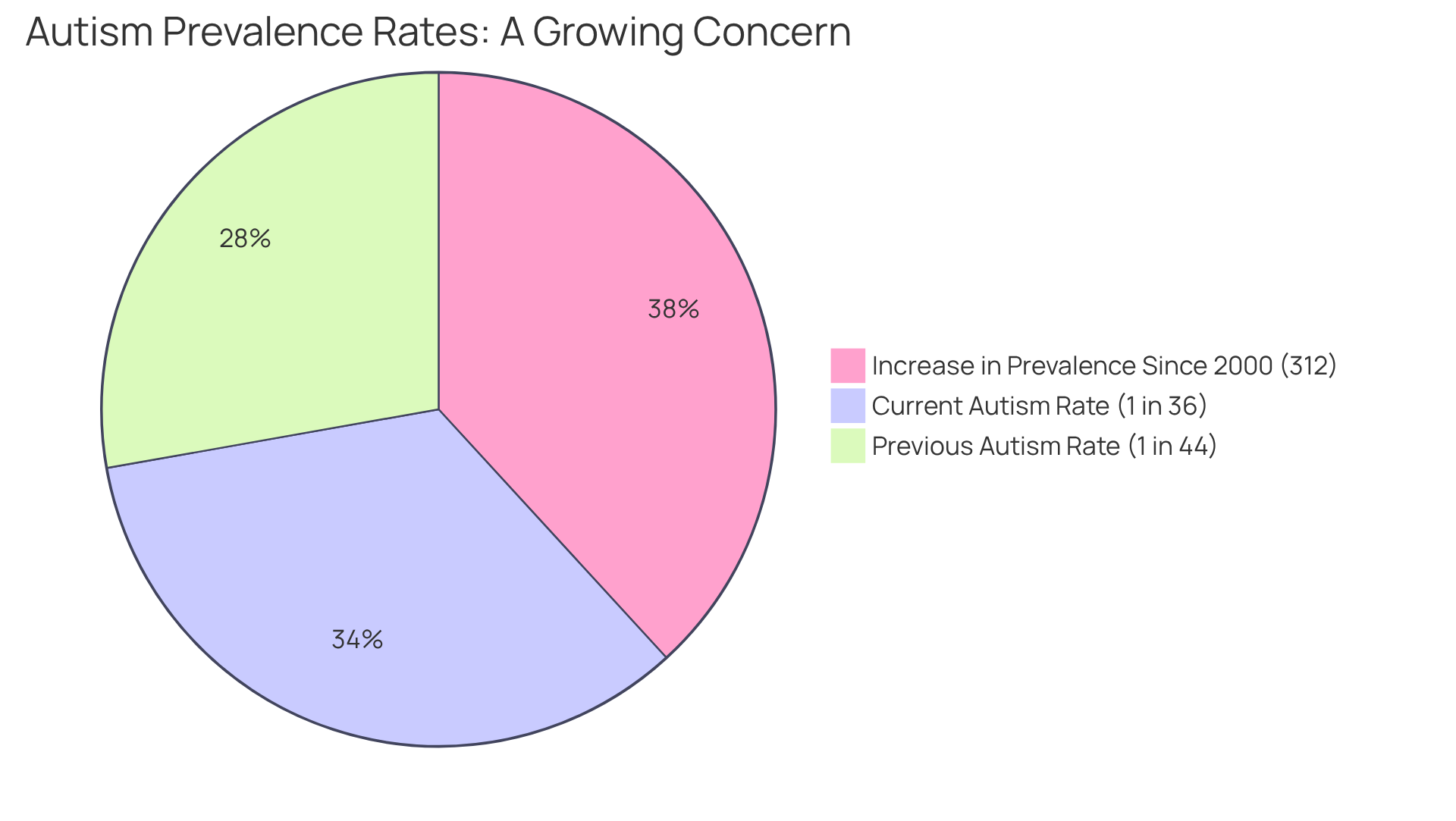
Rising Diagnoses: Historical Trends in Autism Identification
The recognition of developmental disorders has undergone a significant transformation over the past few decades, and this evolution is worth noting. In the past, many cases were misdiagnosed or overlooked entirely, primarily due to a lack of understanding and awareness surrounding these conditions. Thankfully, as educational initiatives and advocacy efforts have gained momentum, the precision of diagnoses has improved remarkably. For instance, the CDC now reports that the autism rate 2023 shows one in 36 children is diagnosed with a developmental disorder, a notable increase from one in 44 just two years ago. This rise in the autism rate 2023 can be attributed to enhanced diagnostic standards and a growing societal awareness of autism spectrum conditions (ASD).
Research shows that the evolution of diagnostic practices has resulted in a staggering 175% increase in diagnoses from 2011 to 2022, particularly among young adults and females, potentially impacting the autism rate 2023. The autism rate 2023 has increased from 2.3 per 1,000 people to 6.3 per 1,000 people during this period. While the male-to-female ratio for autism is estimated at 4:1, recent studies indicate that this gap may be narrowing as more females are recognized and diagnosed. Additionally, the heightened awareness has highlighted disparities in diagnosis rates among racial and ethnic minority groups, with an astonishing 315% rise in diagnoses among Hispanic youths, underscoring the need for culturally informed care.
Experts emphasize the importance of ongoing education and advocacy to ensure that all children receive the support they need, particularly considering the autism rate 2023. As Dr. Stephanie Seneff poignantly asked, 'Will half of US children have this condition by 2025?' This question underscores the urgency of addressing the increasing prevalence rates, particularly the autism rate 2023, and the necessity for a collective community effort to promote understanding and acceptance of these conditions. Ultimately, this will lead to improved outcomes for individuals on the spectrum, as we work together to foster a more inclusive environment.
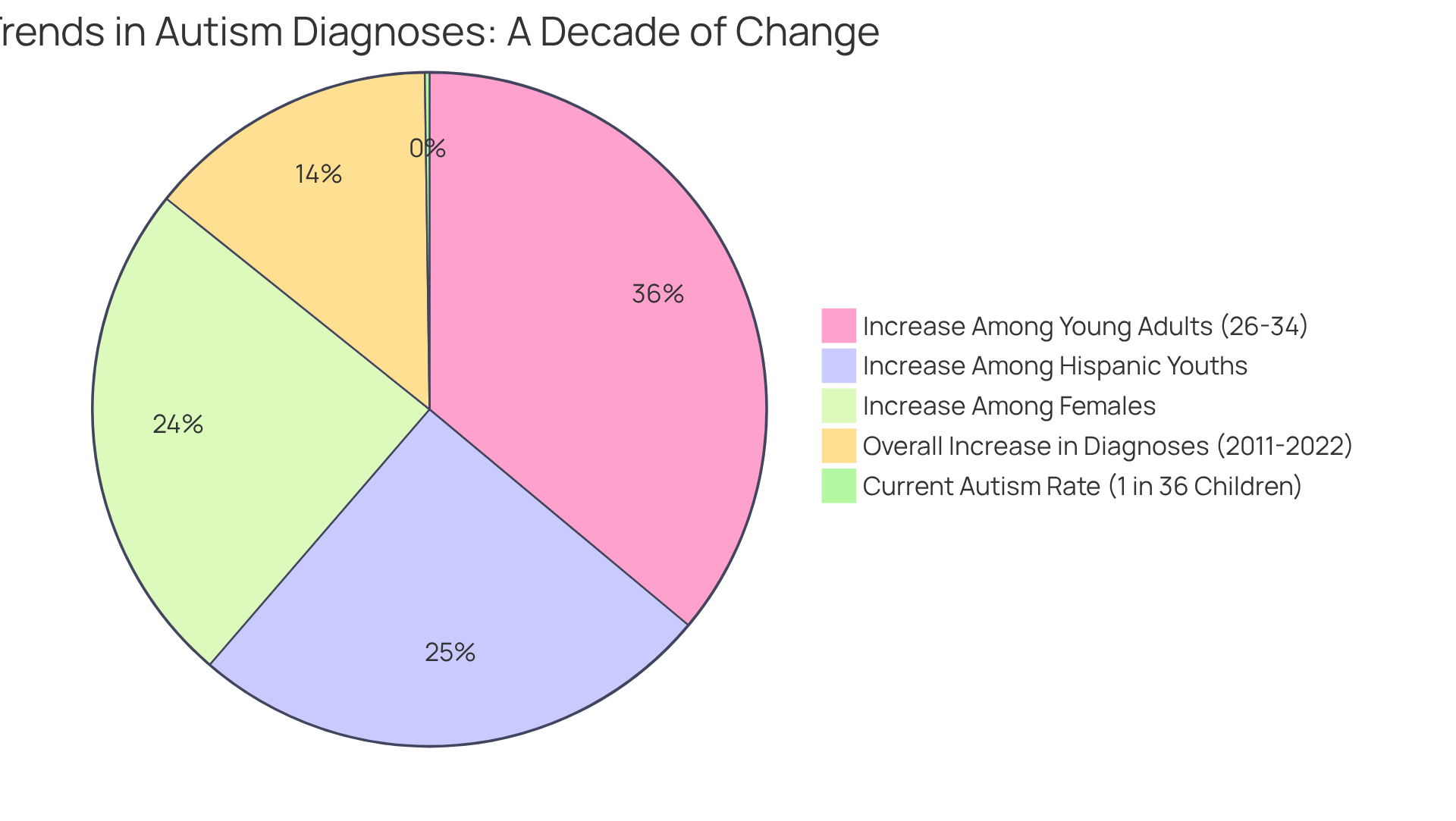
Gender Differences: Autism Rates Among Boys and Girls
Research shows that this condition is identified at a notably greater frequency in boys compared to girls, with an estimated ratio of 4:1. This disparity can be concerning for parents, as it is partly due to the different ways the condition manifests in females, which can lead to underdiagnosis. Girls often display subtler symptoms, such as social withdrawal, anxiety, and a tendency to mask their challenges. It's crucial for parents to recognize these signs early on.
For instance, while boys may exhibit more pronounced difficulties in social communication, girls might develop advanced vocabulary skills yet struggle with social interactions. This nuanced presentation can result in girls being diagnosed later in life or misdiagnosed with conditions like anxiety or depression. Understanding these differences is vital for parents who want to support their daughters effectively.
Additionally, girls with developmental disorders often exhibit less severe forms of repetitive and restricted behaviors compared to boys, further complicating the diagnostic process. Recognizing these gender-specific differences, including the female protective effect theory, is essential for ensuring timely intervention and support for autistic girls. By being aware of these signs and seeking help, parents can play a pivotal role in their daughters' development and well-being.
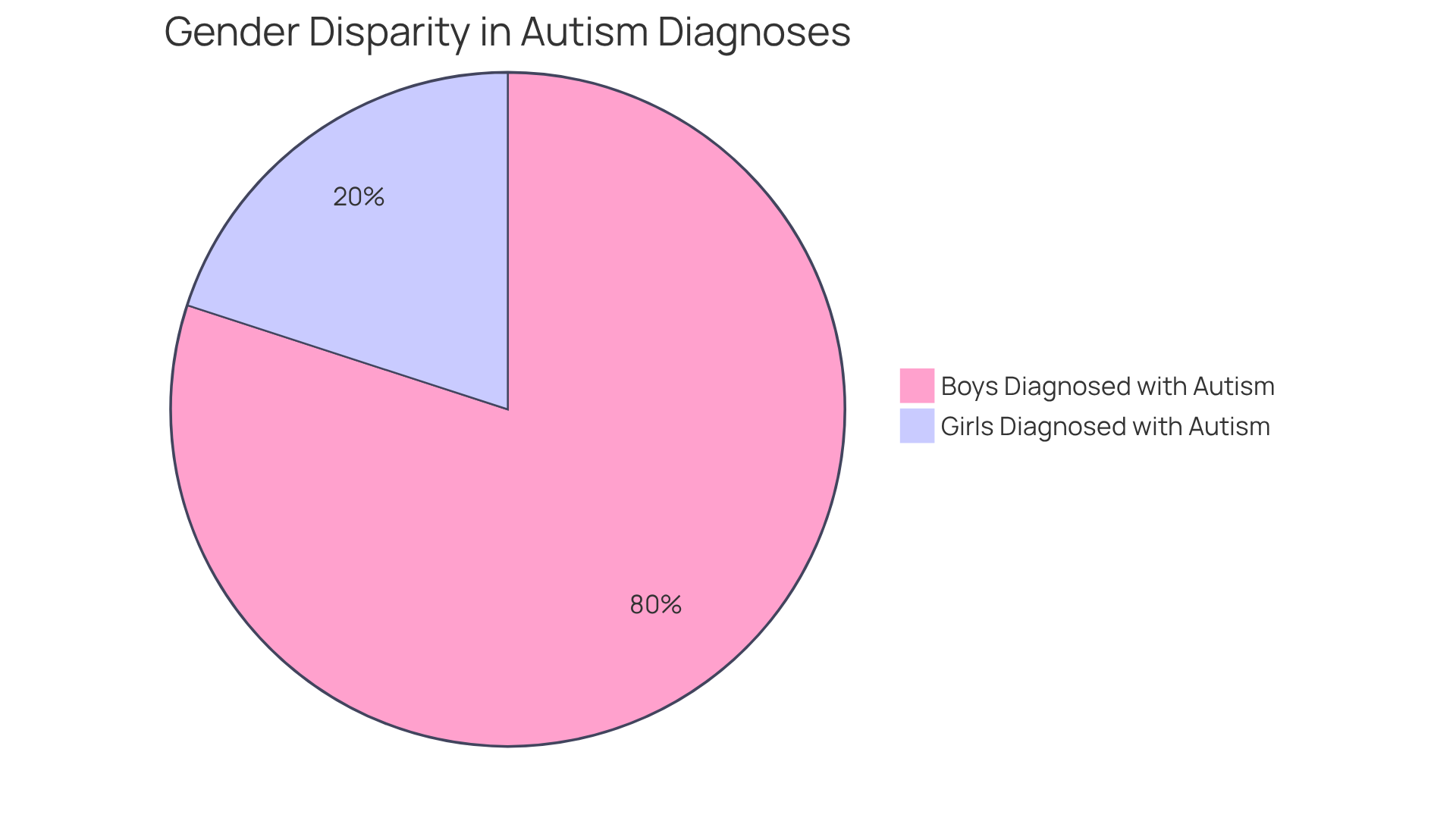
Socioeconomic Factors: How Income and Education Impact Autism Rates
Socioeconomic factors play a crucial role in influencing diagnosis rates of autism and access to essential resources. Families with higher income and education levels often find themselves with better access to healthcare and early intervention services. For instance, a study conducted in New Jersey revealed that children from more affluent census tracts experienced a higher occurrence of developmental disorders. This finding underscores how access to pediatric and developmental services directly impacts diagnosis rates.
In 2022, the diagnosis rate of autism spectrum disorder (ASD) was 6.3 per 1000 individuals, indicating that the autism rate 2023 may reflect an overall rise in these rates. This disparity highlights the urgent need for equitable access to resources for individuals on the autism spectrum. It is essential that all families, regardless of their socioeconomic background, are able to obtain the necessary support they deserve.
As Luke P. Grosvenor aptly noted, "Patterns of increase in diagnosis rates of developmental disorders reflect a need for expanded health care services and continued research on sociodemographic disparities among this growing population." As advocacy efforts continue to expand, addressing these disparities becomes vital for improving outcomes for children with developmental disorders and their families. Together, we can work towards a future where every family has the support they need to thrive.
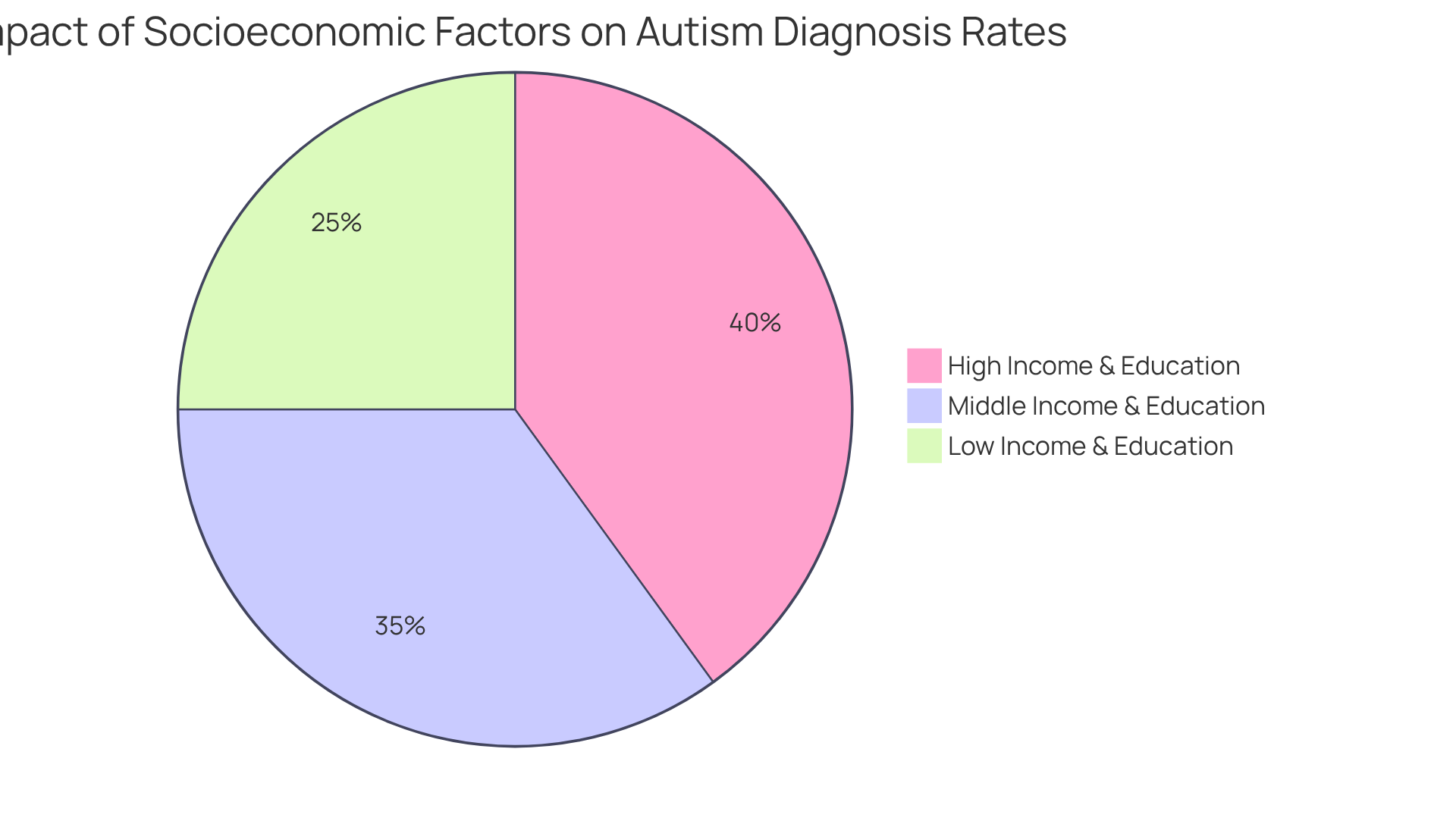
Early Intervention: The Key to Improved Outcomes for Autistic Children
Timely intervention plays a vital role for individuals with autism, significantly enhancing their communication, social skills, and behavioral outcomes. Research shows that programs initiated during early childhood can nurture essential skills, helping to alleviate the severity of symptoms. For instance, children who start therapy by age two are three times more likely to thrive in inclusive educational settings compared to those who begin later. Parents are encouraged to seek evaluations and interventions as soon as they notice developmental concerns; early diagnosis is closely linked to improved long-term outcomes.
Effective early childhood programs, particularly those that incorporate Applied Behavior Analysis (ABA) therapy, have proven that 50-75% of children receiving intensive therapy for two years or more exhibit remarkable progress in cognitive and adaptive functioning. Moreover, early intervention not only aids in skill development but also promotes emotional recognition and expression, addressing the difficulties many autistic individuals face in understanding emotions.
By prioritizing early intervention, caregivers can unlock their children's potential and pave the way for a brighter future. Remember, your proactive steps can make a significant difference in your child's journey. If you have concerns, don’t hesitate to reach out for support and resources—you're not alone in this.
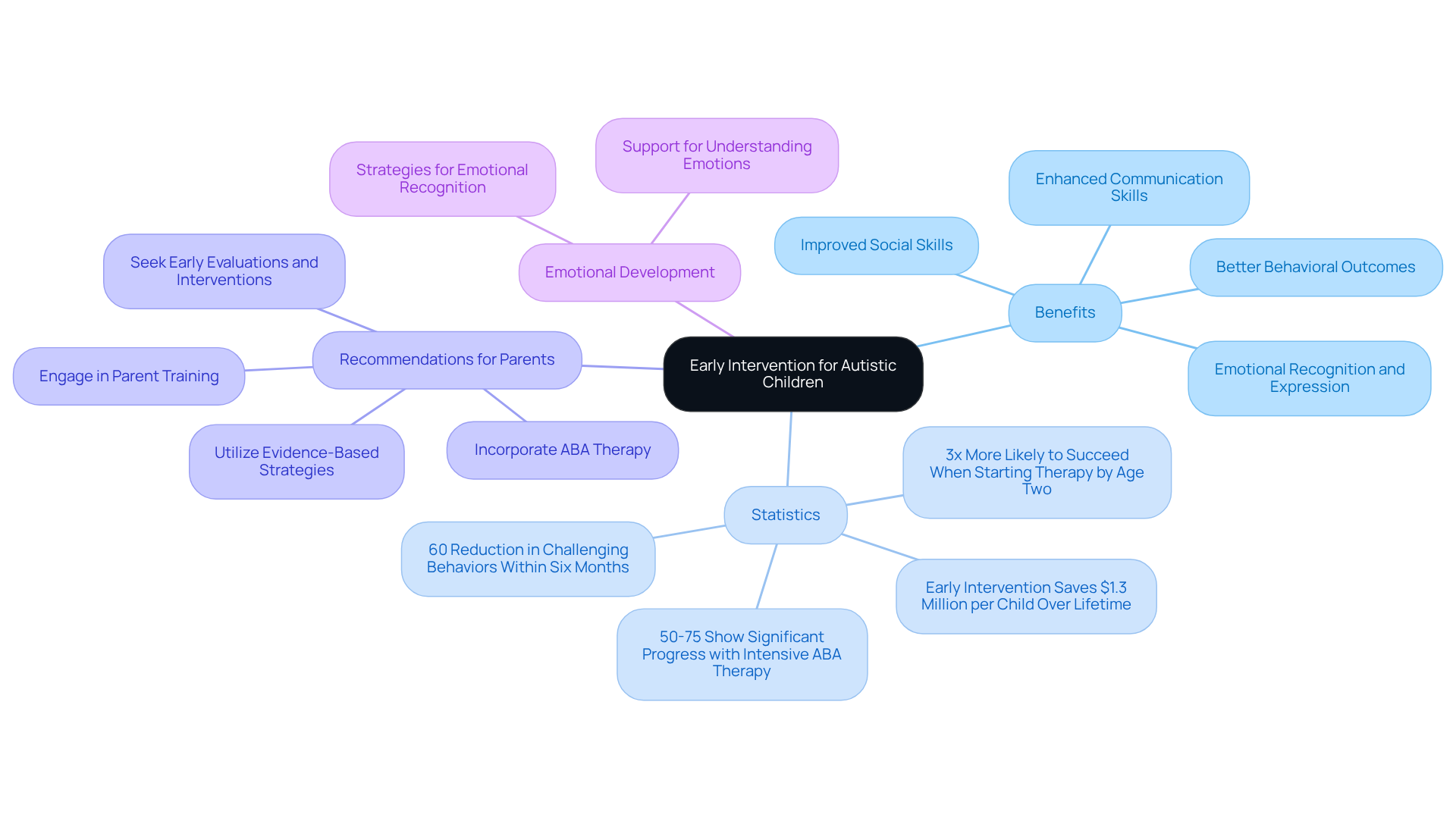
Community Support: Resources for Parents of Autistic Children
Community assistance is crucial for caregivers of autistic individuals, offering essential resources and fostering a sense of belonging. Community organizations and support groups provide spaces where caregivers can share their experiences, seek guidance, and find emotional support from those who truly understand their challenges.
According to data from the CDC, the autism rate 2023 shows that 1 in 31 children in the U.S. is diagnosed with a developmental disorder, an increase from the previous rate of 1 in 36. This statistic underscores the urgent need for robust community networks.
Organizations like Circle Care Services exemplify effective local initiatives, offering caregiver training, social skills development, and behavior therapy to assist families navigating the complexities of autism. Furthermore, support groups have been shown to significantly alleviate the stress that caregivers often face, with many reporting improved coping strategies and emotional resilience. In fact, caregivers of individuals with autism experience more stress than those of neurotypical children, highlighting the importance of these support systems.
ASD Media serves as a vital resource, connecting caregivers to these organizations and providing access to a wealth of information and support. By engaging with community resources, parents can enhance their understanding of autism and foster a collaborative environment that benefits both their children and themselves.
As Temple Grandin wisely states, 'I am different, not less,' reminding us of the unique strengths present within the neurodiverse community.
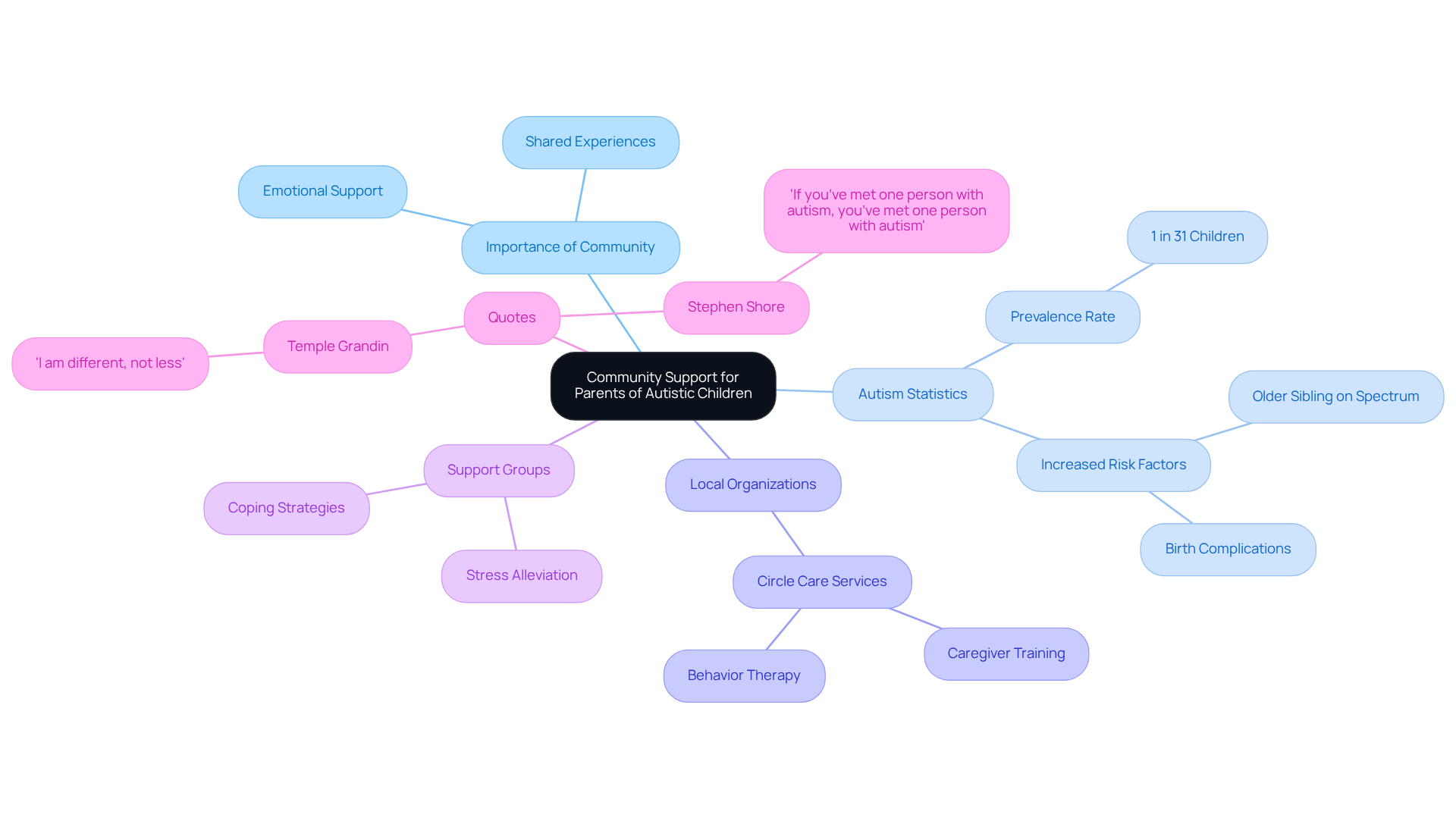
Economic Impact: Understanding the Financial Burden of Autism
The financial burden of raising a child with developmental differences can be overwhelming, encompassing therapy, medical care, and educational support. In 2023, families may find themselves spending between $17,000 and $21,000 more each year compared to those with neurotypical children. As Carol Tatom points out, "youngsters with developmental disorders can require anywhere between $17,000 and $21,000 annually in additional support compared to neurotypical children." This significant cost can place immense pressure on families.
Consider the average cost of Applied Behavior Analysis (ABA) therapy, which can reach up to $120 per hour. This leads to potential annual expenses of $249,600 for 40 hours of therapy each week. Tatom emphasizes, "quite frankly, those figures make therapy a challenge for many families." Many parents struggle to access affordable services, which can heighten their stress and anxiety.
While approximately 21% of individuals with disabilities, including autism, are employed, nearly 60% of individuals with autism in the U.S. find employment after receiving vocational rehabilitation services. This highlights the critical role these services play in securing jobs and workplace accommodations. Understanding these expenses is vital for parents seeking financial aid and preparing for their children's future needs.
Fortunately, various funding options exist, including:
- state-funded programs
- insurance coverage
- scholarships—especially in states like Indiana and California
These resources can alleviate some of the financial strain, allowing families to focus on their children's development and well-being.
It's also important to note that the average age of diagnosis for this condition is 5 years, with the average age of first intervention being 4.7 years. This context can help families navigate the challenges they face, fostering a sense of hope and support as they seek to provide the best for their children.

Co-occurring Conditions: Recognizing Associated Challenges with Autism
Many parents of children with developmental disorders often find themselves navigating additional challenges, such as ADHD, anxiety, or sensory processing issues. For instance, research shows that around 30% of youth with autism also meet the criteria for ADHD. Furthermore, 25% of individuals with Autism Spectrum Disorder (ASD) experience immune deficiency and dysfunction. Recognizing these overlapping conditions is crucial for parents, as it ensures that their children receive the comprehensive care they deserve. By addressing these extra needs, families can significantly enhance their children's overall outcomes and quality of life.
Understanding the connection between developmental disorders and anxiety is particularly important. Anxiety can exacerbate behavioral problems and hinder social interactions, making it vital for parents to be aware of these dynamics. As Julie Rasmuson wisely points out, 'Other medical or mental health comorbidities that could be causing symptoms should be ruled out when determining meaningful and individualized interventions.' By acknowledging and managing these co-occurring conditions, parents can create a nurturing environment that supports their children's growth and development.
Ultimately, fostering a supportive atmosphere tailored to each child's unique needs is essential. Parents are encouraged to seek resources and professional guidance to ensure their children receive the individualized care that can lead to a brighter future.
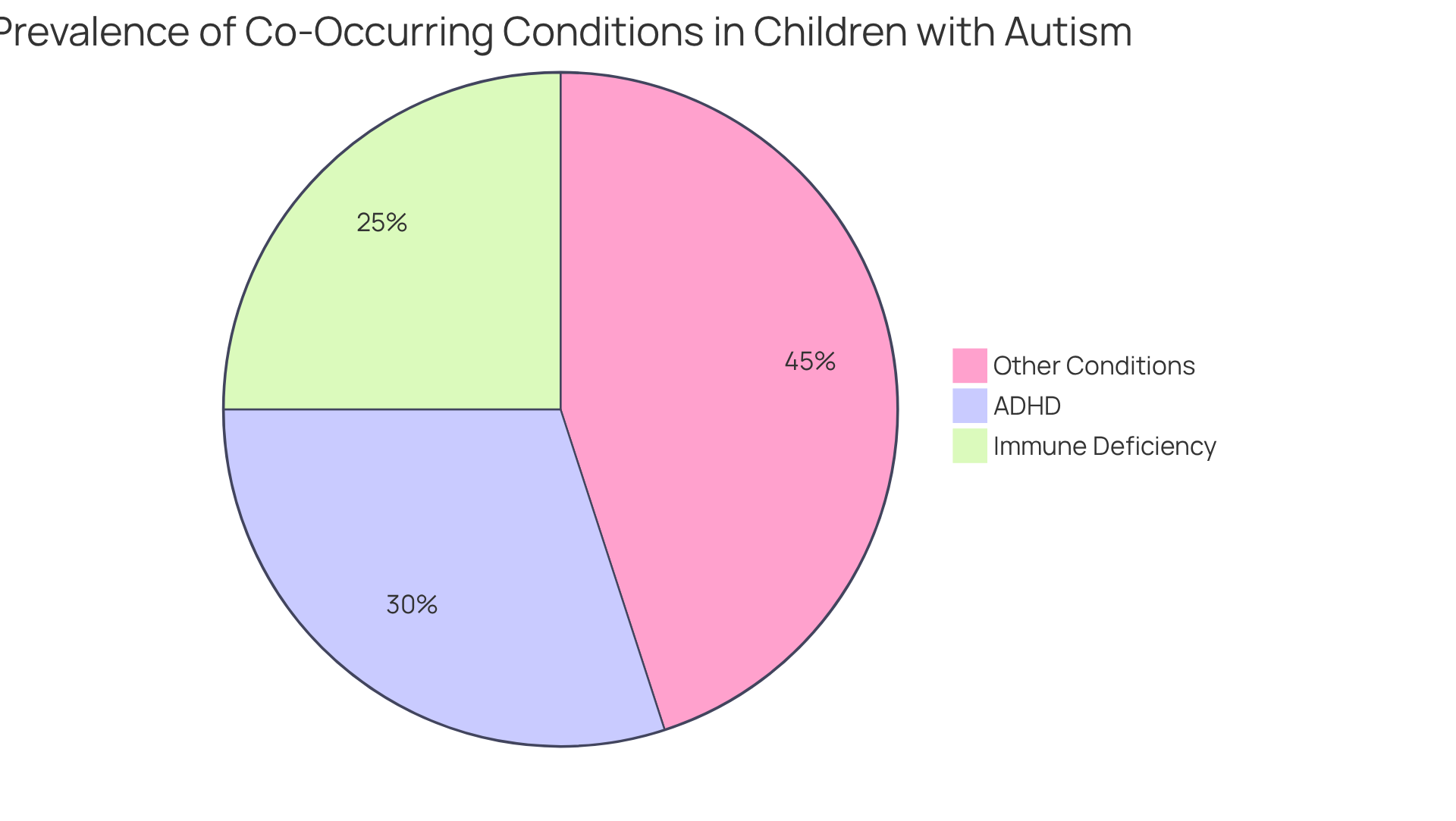
Future Predictions: What to Expect in Autism Prevalence and Support
As our understanding of autism continues to evolve, we can hope for a future where the autism rate 2023 stabilizes or even decreases, thanks to improved early detection. Yet, it’s important to recognize that the demand for assistance services is likely to rise. In fact, the financial burden of treatment for autism is projected to reach a staggering $461 billion by 2025, highlighting the critical need for early detection and timely interventions. As guardians, it’s essential to stay informed about new resources and advocacy initiatives to ensure that your children receive the vital support they need as the landscape of autism care transforms.
Significantly, it’s encouraging to note that 73.6% of autistic high school students receiving special education services graduate with a regular diploma. This statistic underscores the positive outcomes associated with early assistance. As one supporter insightfully remarked, 'The future of support services is promising, with more families obtaining access to the care they require, resulting in improved outcomes for youth on the spectrum.'
Moreover, we must acknowledge the disparities in autism diagnosis among different racial and socioeconomic groups, as these factors greatly influence access to care and contribute to the autism rate 2023. By staying informed about these developments, you empower yourself to advocate effectively for your children and make the most of the resources available to you. Together, we can navigate this journey and create a brighter future for our children.
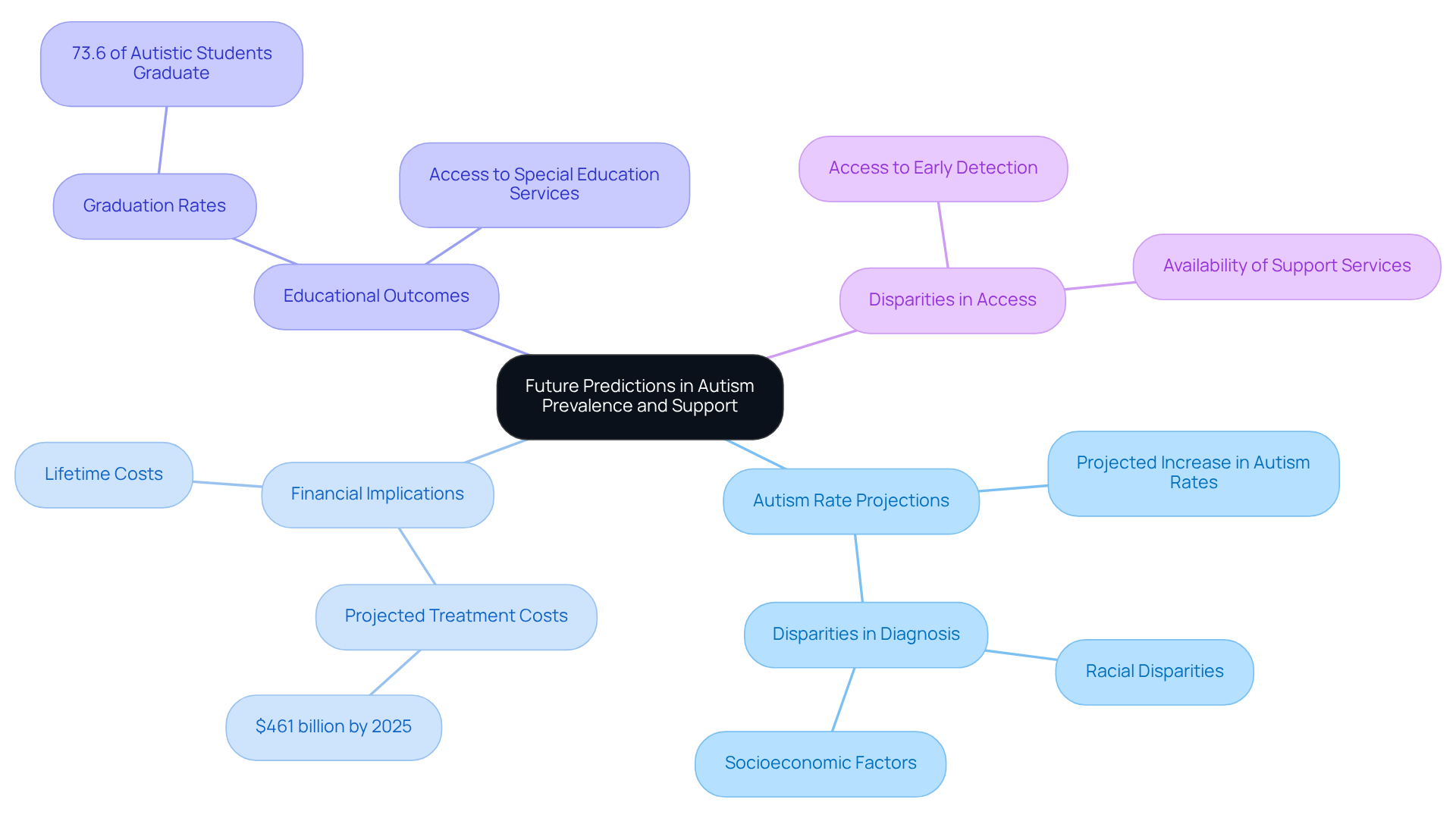
Conclusion
The insights presented on autism rates in 2023 emphasize the urgent need for awareness and proactive engagement among parents and caregivers. With current statistics revealing that 1 in 36 children are diagnosed with autism, it is essential to grasp the changing landscape of autism identification and support. This understanding empowers families to seek early intervention and effectively utilize available resources, ultimately enhancing their children's developmental outcomes.
Throughout the article, key themes emerge, such as the significance of early diagnosis, the influence of socioeconomic factors, and the necessity of community support. The rising prevalence of autism diagnoses highlights the urgency for parents to closely observe developmental milestones and access support networks that can provide guidance and assistance. Additionally, acknowledging gender differences in autism presentation and the financial implications of care can help families navigate their unique challenges more effectively.
In conclusion, the journey of supporting a child with autism is enriched by knowledge, community, and timely intervention. As the autism rate continues to evolve, it is crucial for parents to advocate for their children, seek out necessary resources, and engage with supportive networks. By fostering an informed and proactive approach, families can contribute to a future where individuals on the spectrum receive the understanding and support they deserve, paving the way for a more inclusive society.
Frequently Asked Questions
What resources does ASD Media provide for parents of children with autism?
ASD Media offers informative articles, engaging webinars, and interactive community forums where parents can share experiences and strategies.
What is the current autism prevalence rate in the U.S.?
As of 2023, the autism prevalence rate is approximately 1 in 36 youths diagnosed with autism spectrum disorder (ASD).
Why is early diagnosis important for children with autism?
Early diagnosis is crucial because it enhances access to effective support services and resources, leading to better outcomes for children on the spectrum.
What percentage of autistic 8-year-olds in the U.S. experience profound developmental disorder?
Around 26.7% of autistic 8-year-olds in the U.S. experience profound developmental disorder.
How has the autism diagnosis rate changed over time?
The autism diagnosis rate has increased significantly, showing a 312% rise since 2000 and a 175% increase from 2011 to 2022.
What demographic disparities exist in autism diagnoses?
Boys are diagnosed with autism at a rate approximately 4.2 times higher than girls, and there is a notable increase in diagnoses among Hispanic youths, which has risen by 315%.
What is the significance of community support for families dealing with autism?
Community support is vital as it provides a nurturing atmosphere for families, helping them manage the complexities of supporting individuals with autism and enhancing collective learning and growth.




